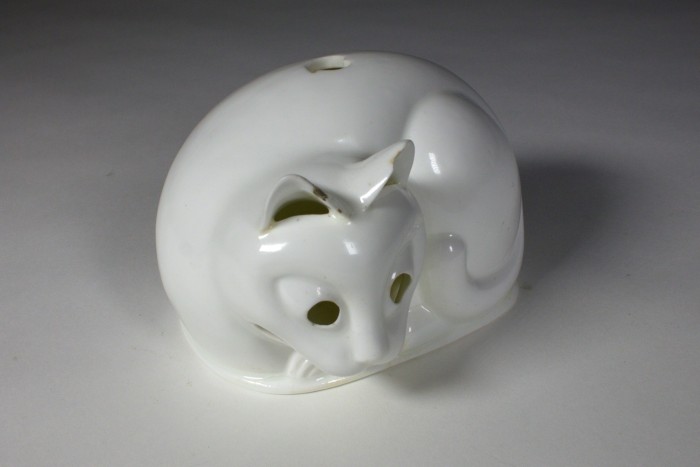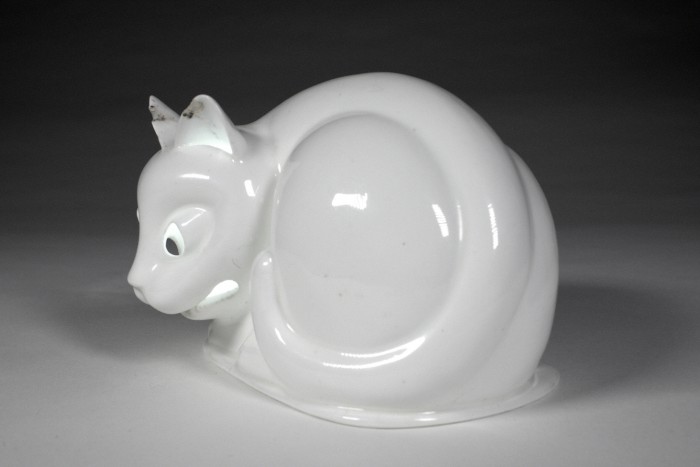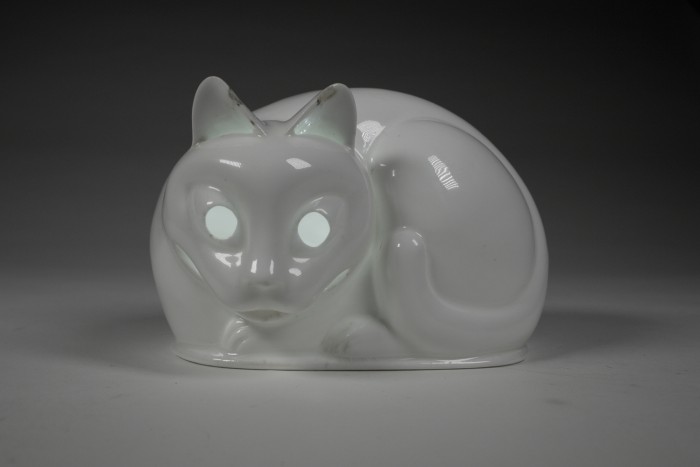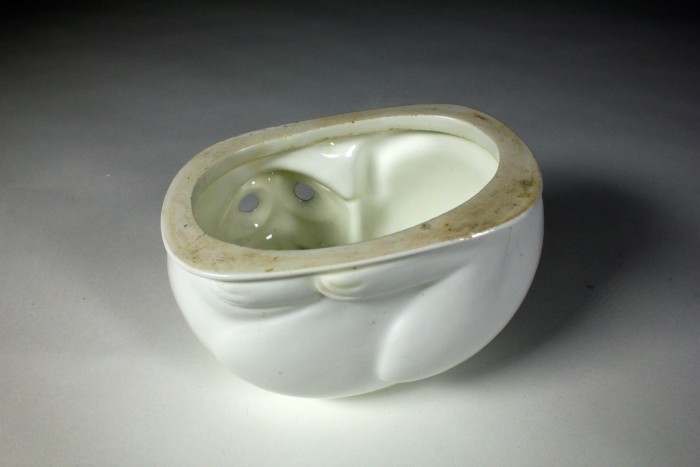In China during the Kangxi Era (1661 to 1722), it was believed that placing one of these cats in your window with a candle burning inside would scare away vermin. A convenient and useful object to be sure! Cat night lights were made from the 17th to the 19th century.
I am not certain as to the age of this though I think it is much older than the seller believed. It was advertised to me as being late 19th to early 20th century. On first examination I was inclined to agree. Its thin and even walls had me thinking it was slip cast but closer examination revealed otherwise.
This cat has been very finely press moulded. I can trace my fingertips into subtle channels left on the interior by the hands that pressed it. The area at the back of the eyeballs has been scalloped with the fingertips of a long ago potter. You know as soon as your fingertips stroke the indentations that this is how they came to be. There is a slight stretch mark from a slab being pushed just a little too far around an edge on the interior. All details that point to it being pressed. This is probably the most skillful example of press moulding I have ever examined.
Press moulding is a much underrated skill these days. People think it is just a matter of pushing clay in a mould. It is not. It is a refined skill learned through much practice. This piece exhibits such a delicacy of touch that it must have been done by only the most skilled craftsperson. The quality of the pressing is superb.
My skills would not be up to pressing as finely as this. This would be a slip cast object if it were being made today. Slip casting is much lower on the skills level. Once the mould is made, someone like say a teenager who needs to pay for his classes could be hired to cast the copies. :-)
The quality of the porcelain is exquisitely fine. The body is a flawless creamy translucent white. My experience with 19th century Chinese porcelain, limited though that may be, is that it is rather coarse by comparison and much less pure.
There is slight staining at the openings where smoke from a candle would have escaped. The area around the peach shaped opening in the back, the area around the mouth, the openings in the ears and the iris holes all show signs of smoke damage.
This lamp may once have had glass eyes. The corneas would have glowed when the candle was burning. All the more terrifying for the mice I suppose. Some Kangxi examples retain their glass eyes.
There are extremely delicate marks carved into the surface of the porcelain to give the suggestion of fur. I missed them at first because the lines are just so subtle. They are almost hidden by the glaze but visible if you look very closely. It is hard to tell even where the glaze ends and the body begins when you look into the surface. Glaze and body form a perfect harmony.
The exceptional delicacy of the details, the extremely fine craftsmanship, the superb quality of the porcelain and the fusion of glaze and body have led me to the conclusion that this may in fact be a Kangxi piece. I cannot say that with any certainty though. It is also possible that this could be Hirado (Japan). To me, the modelling most resembles Chinese examples. If you are interested, I would suggest you search out other cat night lights online and form your own opinion.
One difference this piece shows when compared to others is how the foot of it becomes an oval rather than taking the form of the cat right to the edge. I have a theory about that too. The examples you can see online often have carved wood bases that are fitted to the forms. Some were remounted onto ormolu bases to fit into a European aesthetic. I think that mine was once fitted to a porcelain box or base. This night light could in fact be the lid to a container that held the candle. The oval shaped foot is how it was fitted to that base base. Do I know this to be true? No, but it seems plausible. An oval ring is how a potter might make a practical inset lid.
I plan to restore the damage to the ears. I would not touch the areas of staining to the openings as that is part of its practical, not accidental history. I may also make the lower container I imagine this piece to once have been fitted to. If Louis XV can have ormolu bases made for what were already antiques, then I can make the box I imagine it covering. It will be up to future owners to decide if the two should remain together. Not in any hurry though. For now I will enjoy it just as it is.
Where it is lit in my images, it is not with a candle. At this point in its life, I would prefer to minimize risk. I am using a small battery operated led light instead.
The images presented here will give you a good indication of its physical nature. Next week, you will see its more transformative nature in the first of an ongoing occasional series called “After Dark”.





